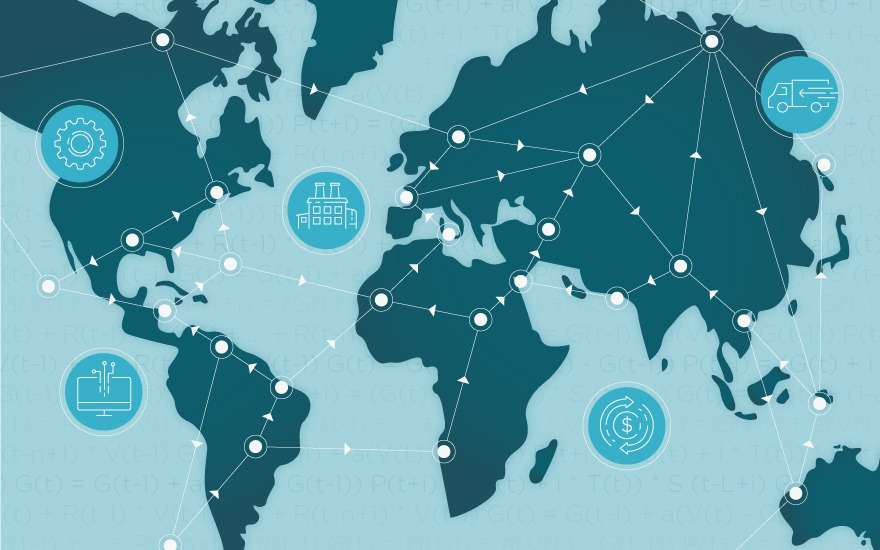
Supply chain management is synonymous with problem-solving. Customers want their products and they want them now. Prices on raw materials fluctuate. Geopolitical conflict forces production changes. Competition is looking for a leg up. A pandemic shakes the globe. Buying habits transform. Climate change puts sustainability into focus.
Supply chain managers need to adjust to changing dynamics and invent solutions to make their businesses better and their products more accessible to consumers.

The Wisconsin School of Business talked with Jake Dean, director of the School’s Grainger Center for Supply Chain Management, to explore the complex challenges supply chain managers face and their pivotal roles as business problem solvers.
WSB: How does the global nature of business present challenges for supply chain managers?
Jake Dean: Supply chains are inherently global. It’s difficult to think of a supply chain that is entirely contained within the borders of one country. It is very common, for example, to have supply chains where raw materials from the U.S., India, and China arrive at a factory in Vietnam and are transformed into a final product which is then transported to North America for distribution to retailers. Every global transaction and relationship is influenced by trade agreements (and trade wars), physical distribution methods, intellectual property concerns, language differences, and cultural practices, each adding its own dimension of complexity. Supply chain managers have to be experts on factors as diverse as geopolitical risk and cultural dexterity.
WSB: Has COVID-19 altered the discipline of supply chain management going forward?
JD: Yes! If there has been one positive outcome of COVID-19, it’s been the elevation and recognition of supply chain management as the critical business function that ensures companies can still make money and consumers’ needs can be fulfilled. This newfound recognition is happening all the way from CEOs to the general public. Sure, there were early issues, and toilet paper and Lysol wipes continue to be in short supply, but if you think about the fact that the global economy was imploding as a pandemic raged, yet store shelves remained virtually as plentiful as ever, that’s pretty amazing. Supply chain management is the discipline that made that happen.
WSB: What’s a recent supply chain innovation that an average consumer might notice?
JD: Consumer packaged goods (CPG) companies are adapting to an environment where eye-catching packaging and dominant in-store shelf placement provide zero value to online customers. In the brick-and-mortar retail world, a product’s packaging has two functions: safely contain the product and promote the product to customers. These dual functions more often than not lead to packaging that looks great, but isn’t shaped for optimal supply chain handling and transportation without being additionally packaged in a cardboard box. Online, the packaging only needs to act as, well, packaging, so it’s possible to design something that contains the product AND is optimized for the supply chain. Amazon and Procter & Gamble recently collaborated on this, for example.
WSB: What will be the biggest challenge facing supply chain managers in the next 5-10 years?
JD: An early lesson we teach our students is that a company’s supply chain can be efficient or responsive:
- Efficient supply chains produce and deliver large quantities of low-margin products with predictable demand (Campbell’s chicken noodle soup or a basic light fixture).
- Responsive supply chains produce and deliver smaller quantities of higher-margin products where demand is more variable and customers are more demanding (luxury goods or custom machine parts).
This efficient-responsive spectrum drives all supply chain design and execution decisions. Customers increasingly expect the fast delivery times and wide product assortments of responsive supply chains for all products, so in the coming years supply chain managers are going to need to figure out ways of making their supply chains more responsive. This will be tough, as the high margins in traditionally responsive supply chains offset the costs of responsiveness. How to pay for or eliminate those costs in low-margin supply chains is the challenge.
The Wisconsin School of Business offers a one-year, STEM-designated master of science degree, a two-year STEM-designated full-time MBA specialization, and a new undergraduate major in supply chain management.
All three programs are delivered through the School’s dedicated SCM knowledge center, the Grainger Center for Supply Chain Management.
Read more about supply chain management at WSB:
WSB Announces New Undergraduate Major in Supply Chain Management
PPE and COVID-19: WSB Faculty Share Expertise, Collaborate on Solutions
Why is Supply Chain So Important Today?
Wisconsin Leads the Way in STEM in Business Education
Tags: